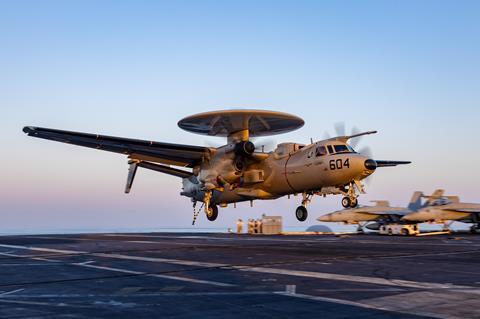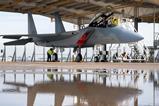The US Navy’s (USN’s) fleet of carrier-based tactical airborne early warning (AEW) aircraft are set to receive a major upgrade.
Northrop Grumman has completed a preliminary design review for a modernisation of the company’s E-2D Advanced Hawkeye turboprop, which will include a complete technology refresh for the cockpit, mission computer and operations station. The navy officially calls the package Delta System Software Configuration 6 (DSSC 6).
In its new configuration the type will be called the E-2D Block II, with retrofits to existing aircraft beginning in 2027 and continuing into the 2030s. Northrop says it will upgrade the US Navy’s entire fleet of 75 aircraft.

“We are integrating digital capabilities to assist in rapidly designing, building, testing and sustaining programmes for our customers, and we will incorporate these advanced capabilities into the E-2D Advanced Hawkeye as part of Block II,” says Janice Zilch, Northrop’s vice-president of multi-domain command and control programmes.

The USN began flying the initial E-2 in 1964, as a carrier-based all-weather airborne battle management platform. In addition to providing early warning against incoming enemy aircraft and missiles, the Hawkeye’s communication systems and powerful 360° air- and sea surface-radar allow its crew to coordinate the actions of friendly fighters and support land forces with airborne radar coverage.
The E-2 type is also operated by Egypt, France, Japan and Taiwan. Northrop says it will negotiate upgrades with those operators separately from the USN programme.
Separately from the Block II upgrades, the navy is in the process of retrofitting the E-2D fleet with an aerial refuelling probe to extend the turboprop’s loitering ability.
By contrast, the Block II improvements will be focused on internal aircraft systems.
“This configuration will improve the aircraft significantly by reducing pilot workload, improving situational awareness and bringing vital readiness and reliability upgrades paired with architecture and cybersecurity improvements,” the navy says.
Completion of the preliminary design review allows Northrop to proceed with detailed design work for the programme, which will include addressing parts obsolescence, improving onboard computing power and data storage, increasing connectivity with other command and control systems and incorporating modular open systems architecture, or MOSA, into the E-2D platform.
MOSA refers to the incorporation of US government-owned hardware and software in major defence programmes, thereby opening those systems up to third party vendors for future upgrades and addition of new capabilities.
The concept is central to the Pentagon’s current procurement strategy, and is being used on marquee programmes such as the US Army’s Future Long-Range Assault Aircraft.
The navy says it plans to fly the first Block II E-2D in 2027.


































